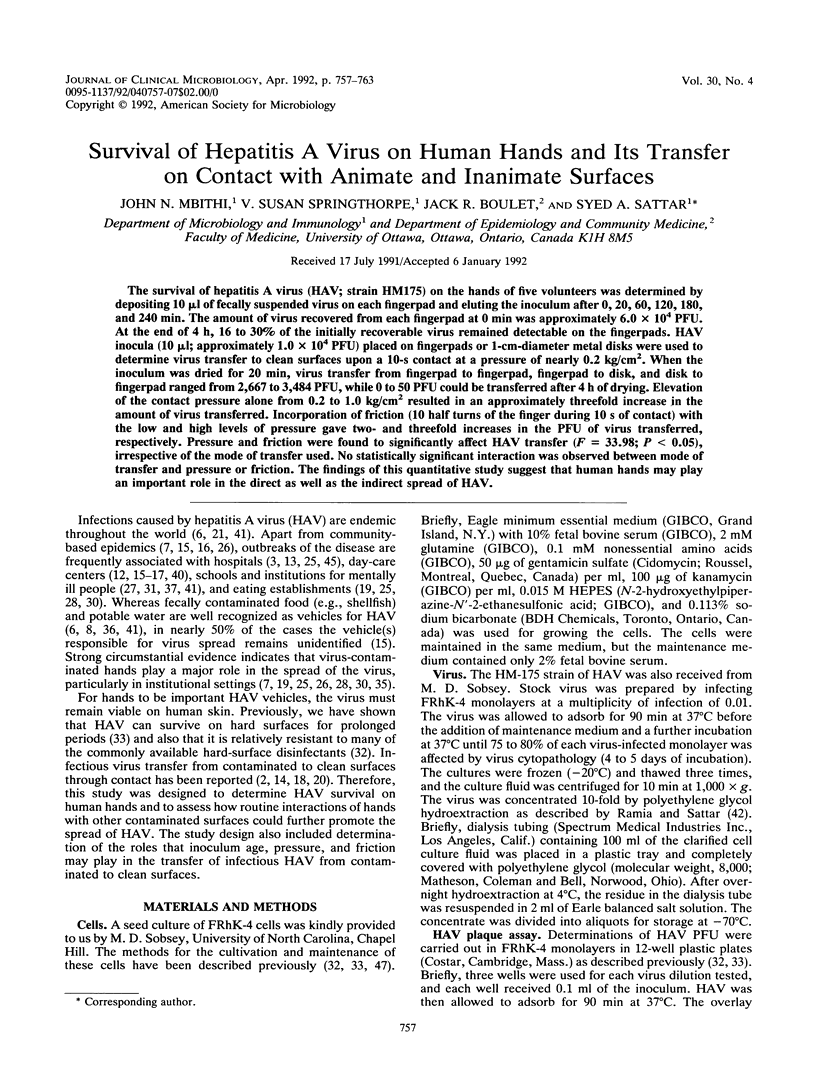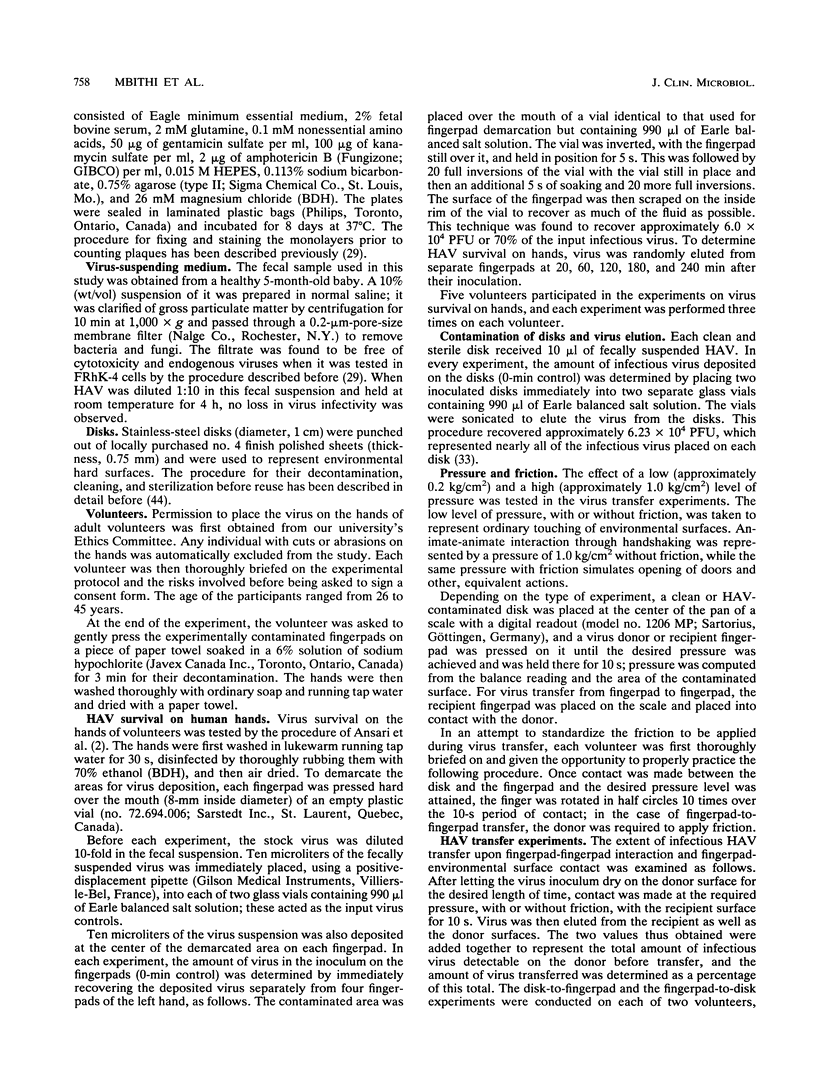Abstract
The survival of hepatitis A virus (HAV; strain HM175) on the hands of five volunteers was determined by depositing 10 microliters of fecally suspended virus on each fingerpad and eluting the inoculum after 0, 20, 60, 120, 180, and 240 min. The amount of virus recovered from each fingerpad at 0 min was approximately 6.0 x 10(4) PFU. At the end of 4 h, 16 to 30% of the initially recoverable virus remained detectable on the fingerpads. HAV inocula (10 microliters; approximately 1.0 x 10(4) PFU) placed on fingerpads or 1-cm-diameter metal disks were used to determine virus transfer to clean surfaces upon a 10-s contact at a pressure of nearly 0.2 kg/cm2. When the inoculum was dried for 20 min, virus transfer from fingerpad to fingerpad, fingerpad to disk, and disk to fingerpad ranged from 2,667 to 3,484 PFU, while 0 to 50 PFU could be transferred after 4 h of drying. Elevation of the contact pressure alone from 0.2 to 1.0 kg/cm2 resulted in an approximately threefold increase in the amount of virus transferred. Incorporation of friction (10 half turns of the finger during 10 s of contact) with the low and high levels of pressure gave two- and threefold increases in the PFU of virus transferred, respectively. Pressure and friction were found to significantly affect HAV transfer (F = 33.98; P less than 0.05), irrespective of the mode of transfer used. No statistically significant interaction was observed between mode of transfer and pressure or friction. The findings of this quantitative study suggest that human hands may play an important role in the direct as well as the indirect spread of HAV.
Full text
PDF






Selected References
These references are in PubMed. This may not be the complete list of references from this article.
- Albert R. K., Condie F. Hand-washing patterns in medical intensive-care units. N Engl J Med. 1981 Jun 11;304(24):1465–1466. doi: 10.1056/NEJM198106113042404. [DOI] [PubMed] [Google Scholar]
- Ansari S. A., Sattar S. A., Springthorpe V. S., Wells G. A., Tostowaryk W. Rotavirus survival on human hands and transfer of infectious virus to animate and nonporous inanimate surfaces. J Clin Microbiol. 1988 Aug;26(8):1513–1518. doi: 10.1128/jcm.26.8.1513-1518.1988. [DOI] [PMC free article] [PubMed] [Google Scholar]
- Azimi P. H., Roberto R. R., Guralnik J., Livermore T., Hoag S., Hagens S., Lugo N. Transfusion-acquired hepatitis A in a premature infant with secondary nosocomial spread in an intensive care nursery. Am J Dis Child. 1986 Jan;140(1):23–27. doi: 10.1001/archpedi.1986.02140150025024. [DOI] [PubMed] [Google Scholar]
- Black R. E., Dykes A. C., Anderson K. E., Wells J. G., Sinclair S. P., Gary G. W., Jr, Hatch M. H., Gangarosa E. J. Handwashing to prevent diarrhea in day-care centers. Am J Epidemiol. 1981 Apr;113(4):445–451. doi: 10.1093/oxfordjournals.aje.a113112. [DOI] [PubMed] [Google Scholar]
- Christenson B., Broström C., Böttiger M., Hermanson J., Weiland O., Ryd G., Berg J. V., Sjöblom R. An epidemic outbreak of hepatitis A among homosexual men in Stockholm. Hepatitis A, a special hazard for the male homosexual subpopulation in Sweden. Am J Epidemiol. 1982 Oct;116(4):599–607. doi: 10.1093/oxfordjournals.aje.a113442. [DOI] [PubMed] [Google Scholar]
- Ekanem E. E., DuPont H. L., Pickering L. K., Selwyn B. J., Hawkins C. M. Transmission dynamics of enteric bacteria in day-care centers. Am J Epidemiol. 1983 Oct;118(4):562–572. doi: 10.1093/oxfordjournals.aje.a113661. [DOI] [PubMed] [Google Scholar]
- Fox M. K., Langner S. B., Wells R. W. How good are hand washing practices? Am J Nurs. 1974 Sep;74(9):1676–1678. [PubMed] [Google Scholar]
- Francis D. P., Maynard J. E. The transmission and outcome of hepatitis A, B, and non-A, non-B: a review. Epidemiol Rev. 1979;1:17–31. doi: 10.1093/oxfordjournals.epirev.a036208. [DOI] [PubMed] [Google Scholar]
- Gingrich G. A., Hadler S. C., Elder H. A., Ash K. O. Serologic investigation of an outbreak of hepatitis A in a rural day-care center. Am J Public Health. 1983 Oct;73(10):1190–1193. doi: 10.2105/ajph.73.10.1190. [DOI] [PMC free article] [PubMed] [Google Scholar]
- Goodman R. A., Carder C. C., Allen J. R., Orenstein W. A., Finton R. J. Nosocomial hepatitis A transmission by an adult patient with diarrhea. Am J Med. 1982 Aug;73(2):220–226. doi: 10.1016/0002-9343(82)90182-6. [DOI] [PubMed] [Google Scholar]
- Gwaltney J. M., Jr, Moskalski P. B., Hendley J. O. Hand-to-hand transmission of rhinovirus colds. Ann Intern Med. 1978 Apr;88(4):463–467. doi: 10.7326/0003-4819-88-4-463. [DOI] [PubMed] [Google Scholar]
- Hadler S. C., McFarland L. Hepatitis in day care centers: epidemiology and prevention. Rev Infect Dis. 1986 Jul-Aug;8(4):548–557. doi: 10.1093/clinids/8.4.548. [DOI] [PubMed] [Google Scholar]
- Hadler S. C., Webster H. M., Erben J. J., Swanson J. E., Maynard J. E. Hepatitis A in day-care centers. A community-wide assessment. N Engl J Med. 1980 May 29;302(22):1222–1227. doi: 10.1056/NEJM198005293022203. [DOI] [PubMed] [Google Scholar]
- Hall C. B., Douglas R. G., Jr, Geiman J. M. Possible transmission by fomites of respiratory syncytial virus. J Infect Dis. 1980 Jan;141(1):98–102. doi: 10.1093/infdis/141.1.98. [DOI] [PubMed] [Google Scholar]
- Hanrahan J. P., Zimmerman K. L., Toly M. H., Prowda R. L., Grabau J. C., Morse D. L. An outbreak of hepatitis A linked to a food handler in a cafeteria. N Y State J Med. 1984 Jan;84(1):10–13. [PubMed] [Google Scholar]
- Hendley J. O., Wenzel R. P., Gwaltney J. M., Jr Transmission of rhinovirus colds by self-inoculation. N Engl J Med. 1973 Jun 28;288(26):1361–1364. doi: 10.1056/NEJM197306282882601. [DOI] [PubMed] [Google Scholar]
- Isaacs D., Dobson S. R., Wilkinson A. R., Hope P. L., Eglin R., Moxon E. R. Conservative management of an echovirus 11 outbreak in a neonatal unit. Lancet. 1989 Mar 11;1(8637):543–545. doi: 10.1016/s0140-6736(89)90078-0. [DOI] [PubMed] [Google Scholar]
- Kaneko F., Kawagishi I., Miura Y., Kobayashi K. Secretory IgA in skin and the adjacent mucous membranes. J Dermatol. 1982 Apr;9(2):99–106. doi: 10.1111/j.1346-8138.1982.tb02610.x. [DOI] [PubMed] [Google Scholar]
- Keswick B. H., Pickering L. K., DuPont H. L., Woodward W. E. Survival and detection of rotaviruses on environmental surfaces in day care centers. Appl Environ Microbiol. 1983 Oct;46(4):813–816. doi: 10.1128/aem.46.4.813-816.1983. [DOI] [PMC free article] [PubMed] [Google Scholar]
- Klein B. S., Michaels J. A., Rytel M. W., Berg K. G., Davis J. P. Nosocomial hepatitis A. A multinursery outbreak in Wisconsin. JAMA. 1984 Nov 16;252(19):2716–2721. doi: 10.1001/jama.252.19.2716. [DOI] [PubMed] [Google Scholar]
- Leger R. T., Boyer K. M., Pattison C. P., Maynard J. E. Hepatitis A: report of a common-source outbreak with recovery of a possible etiologic agent. I. Epidemiologic studies. J Infect Dis. 1975 Feb;131(2):163–166. doi: 10.1093/infdis/131.2.163. [DOI] [PubMed] [Google Scholar]
- Lehmann N. I., Sharma D. L., Gust I. D. Prevalence of antibody to the hepatitis A virus in a large institution for the mentally retarded. J Med Virol. 1978;2(4):335–339. doi: 10.1002/jmv.1890020406. [DOI] [PubMed] [Google Scholar]
- Levy B. S., Fontaine R. E., Smith C. A., Brinda J., Hirman G., Nelson D. B., Johnson P. M., Larson O. A large food-borne outbreak of hepatitis A. Possible transmission via oropharyngeal secretions. JAMA. 1975 Oct 20;234(3):289–294. [PubMed] [Google Scholar]
- Lloyd-Evans N., Springthorpe V. S., Sattar S. A. Chemical disinfection of human rotavirus-contaminated inanimate surfaces. J Hyg (Lond) 1986 Aug;97(1):163–173. doi: 10.1017/s0022172400064445. [DOI] [PMC free article] [PubMed] [Google Scholar]
- Lowry P. W., Levine R., Stroup D. F., Gunn R. A., Wilder M. H., Konigsberg C., Jr Hepatitis A outbreak on a floating restaurant in Florida, 1986. Am J Epidemiol. 1989 Jan;129(1):155–164. doi: 10.1093/oxfordjournals.aje.a115104. [DOI] [PubMed] [Google Scholar]
- MOSLEY J. W. Water-borne infectious hepatitis. N Engl J Med. 1959 Oct 1;261:703–contd. doi: 10.1056/NEJM195910012611407. [DOI] [PubMed] [Google Scholar]
- Matthew E. B., Dietzman D. E., Madden D. L., Newman S. J., Sever J. L., Nagler B., Bouton S. M., Rostafinski M. A major epidmeic of infectious hepatitis in an institution for the mentally retarded. Am J Epidemiol. 1973 Sep;98(3):199–215. doi: 10.1093/oxfordjournals.aje.a121549. [DOI] [PubMed] [Google Scholar]
- Mbithi J. N., Springthorpe V. S., Sattar S. A. Chemical disinfection of hepatitis A virus on environmental surfaces. Appl Environ Microbiol. 1990 Nov;56(11):3601–3604. doi: 10.1128/aem.56.11.3601-3604.1990. [DOI] [PMC free article] [PubMed] [Google Scholar]
- Mbithi J. N., Springthorpe V. S., Sattar S. A. Effect of relative humidity and air temperature on survival of hepatitis A virus on environmental surfaces. Appl Environ Microbiol. 1991 May;57(5):1394–1399. doi: 10.1128/aem.57.5.1394-1399.1991. [DOI] [PMC free article] [PubMed] [Google Scholar]
- Mishu B., Hadler S. C., Boaz V. A., Hutcheson R. H., Horan J. M., Schaffner W. Foodborne hepatitis A: evidence that microwaving reduces risk? J Infect Dis. 1990 Sep;162(3):655–658. doi: 10.1093/infdis/162.3.655. [DOI] [PubMed] [Google Scholar]
- Naus M., Everett W., Davies S., Coutts J. A school outbreak of hepatitis A in southwestern Ontario. Can Dis Wkly Rep. 1989 Nov 11;15(45):225–228. [PubMed] [Google Scholar]
- Page C. O., Jr, Remington J. S. Immunologic studies in normal human sweat. J Lab Clin Med. 1967 Apr;69(4):634–650. [PubMed] [Google Scholar]
- Petersen N. J., Bressler G. K. Design and modification of the day care environment. Rev Infect Dis. 1986 Jul-Aug;8(4):618–621. doi: 10.1093/clinids/8.4.618. [DOI] [PubMed] [Google Scholar]
- Pohjanpelto P., Pönkä A. Outbreak of hepatitis A in a day care center in Finland. Scand J Infect Dis. 1985;17(3):331–332. doi: 10.3109/inf.1985.17.issue-3.14. [DOI] [PubMed] [Google Scholar]
- Polakoff S. Reports of clinical hepatitis A from Public Health and hospital microbiology laboratories to the PHLS Communicable Disease Surveillance Centre during the period 1980-1988. J Infect. 1990 Jul;21(1):111–117. doi: 10.1016/0163-4453(90)90853-z. [DOI] [PubMed] [Google Scholar]
- Ramia S., Sattar S. A. Second-step concentration of viruses in drinking and surface waters using polyethylene glycol hydroextraction. Can J Microbiol. 1979 May;25(5):587–592. doi: 10.1139/m79-084. [DOI] [PubMed] [Google Scholar]
- Reybrouck G. Handwashing and hand disinfection. J Hosp Infect. 1986 Jul;8(1):5–23. doi: 10.1016/0195-6701(86)90100-3. [DOI] [PubMed] [Google Scholar]
- Sattar S. A., Lloyd-Evans N., Springthorpe V. S., Nair R. C. Institutional outbreaks of rotavirus diarrhoea: potential role of fomites and environmental surfaces as vehicles for virus transmission. J Hyg (Lond) 1986 Apr;96(2):277–289. doi: 10.1017/s0022172400066055. [DOI] [PMC free article] [PubMed] [Google Scholar]
- Seeberg S., Brandberg A., Hermodsson S., Larsson P., Lundgren S. Hospital outbreak of hepatitis A secondary to blood exchange in a baby. Lancet. 1981 May 23;1(8230):1155–1156. doi: 10.1016/s0140-6736(81)92318-7. [DOI] [PubMed] [Google Scholar]
- Sobsey M. D., Oglesbee S. E., Wait D. A. Evaluation of methods for concentrating hepatitis A virus from drinking water. Appl Environ Microbiol. 1985 Dec;50(6):1457–1463. doi: 10.1128/aem.50.6.1457-1463.1985. [DOI] [PMC free article] [PubMed] [Google Scholar]


